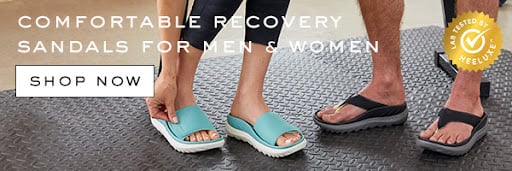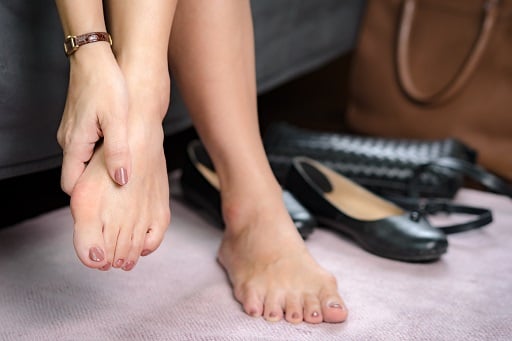From corns and blisters to heel spurs and stone bruises, many foot ailments can hamper your step and make mobility uncomfortable (or even downright painful). And among the most common of those foot afflictions are bunions.
Most bunions begin as minor conditions. When neglected, though, they can cause impaired foot mobility and persistent, recurring pain, and they may even require surgery to remedy. Fortunately, learning how to choose corrective footwear for bunions can avert discomfort and physical complications—and you needn’t sacrifice style to do so.
If you’ve been at your wit’s end trying to find a pair of shoes that don’t aggravate your sensitive feet, you can breathe a sigh of relief. Below, we review how to soothe your feet by finding comfortable shoes for you and your bunions.
What Causes Bunions?
Maybe one of the worst things about bunions is their ability to zap all the fun out of wearing your favorite shoes. One day you’re blissfully strutting down the block, and the next, you’re wincing in pain.
But what causes bunions, and how do you find a corrective footwear solution for tempering the distress they can cause?
What is a bunion? Put simply, bunions (also known as hallux valgus) are bony growths that appear on the big toe joint.1 They are caused by the displacement of the bones at the front end of the foot, which can pull the big toe inward and causes the joint to bulge out along the side of the foot.
Bunion deformity can be observed by this noticeable bump or bulge. Additional signs and symptoms of a bunion include:1
- Redness, soreness, or swelling at the affected joint
- Corns and/or calluses between the first and second toes
- Reduced mobility of the big toe
- Bunion pain that is either persistent or comes in waves
There are factors can lead to a painful bunion. The shape of your foot, whether you have any other foot conditions, your genetics, and related medical conditions can all play a role.
Additionally, wearing shoes that are too small, too narrow, or too high is a known cause.1 And because of this, starting to treat and manage bunions (as well as a host of other podiatric conditions) can start with switching up the type of footwear you routinely wear. You can find out more about how to choose the best running shoes for your feet or find the best shoes for narrow feet.
Best Shoes For Bunions: What To Look For (And What To Avoid)
Many people who have bunions wonder if there are specific bunion correcting shoes. Unfortunately, no pair of shoes will completely heal or correct toes—this can only be achieved with bunion surgery.
However, the right pair of shoes can help bunion sufferers by alleviating pain and soreness, making them easier to live with overall. Fortunately, you can find a bunion-friendly shoe. It’s also possible that better footwear can stall the progression of bunions, which can help defer the need for surgical repair.
Not just any shoes will do, of course. If you have bunions, you will need a pair that offers several distinct qualities that bunion sufferers need to walk tall and stand proud.3 The most comfortable shoes for bunions provide:
- Comfort – When you have bunions, comfort should be a top priority in every pair of shoes you wear—this applies to both daily and special-occasion footwear. Selecting a pair of shoes that fits you properly goes a long way toward maximizing comfort.
Likewise, shoes with laces or straps provide enhanced adjustability, which can also help ease discomfort. Shoes made from canvas or other forgiving fabrics are equally adaptable, giving your feet ample room to flex and move around inside your shoe.
- Support – Some people find their bunions impede their ability to walk or throw them off balance. If this sounds like you, you’ll need a pair of shoes that offer stability and mobility support. Seeking out shoes with contoured insoles, arch support, and plenty of cushioning can provide your feet enhanced stability to stay in motion.
- Wide Width – Because bunions can leave your foot crooked or misshapen, you may need to find a pair of wide shoes that can accommodate these singularities. Just as shoes that are too narrow can cause bunions, they can also aggravate existing bunions. Wide shoes can also accommodate other tools that relieve your bunion deformity, such as toe spacers.
- Toe room – Shoes for bunions should give toes plenty of room, both vertically and horizontally. The very tip of the shoe, known as the toe box, should be roomy and soft to prevent rubbing and relieve pressure or soreness.
Moreover, there are several characteristics of shoes to avoid if you have bunions:
- Tight or narrow shoes
- Shoes whose toe tapers to a pointy
- Shoes with heels higher than approximately two inches
When you can avoid wearing these types of shoes, you can spare yourself undue irritation or a worsening of your foot condition.
Should You Wear Orthopedic Shoes With Bunions?
While there is no such thing as bunion correction shoes, many people with bunions turn to orthopedic shoes to improve pain or make walking less difficult. But are orthopedic shoes the right choice for you?
Orthopedic shoes are a type of special, custom-designed shoe worn by people who live with a range of foot ailments. They are typically prescribed by a podiatrist who ensures they are designed to perfectly fit and support an individual patient’s foot.
Although not everyone needs orthopaedic shoes for bunions, depending on your condition, they could offer some relief. Many of the benefits of wearing orthopedic shoes can also benefit people with bunions.
Orthopedic shoes provide:4
- Roominess – Orthopedic shoes give your feet all the space they need to stay comfortable. And because many orthopedic shoes offer extra spacious toe boxes, they can be helpful for bunion sufferers to wear. Not only can roomier toe boxes keep your feet from feeling cramped, but they can also prevent superficial injuries like blisters, calluses, and sores.
- Advanced support – Because they’re used to treat an array of foot issues, most orthopedic shoes are designed to be extra supportive. Specifically, arch support can promote proper foot alignment, which can help manage bunion symptoms.
- Pain relief – For people recovering from bunion-related injuries, orthopedic shoes may provide comfort and ease pain. Moreover, if you’re recovering from bunion surgery, slipping into a pair of orthopedic shoes could bring you some post-operation relief.
If you’re not ready to invest in a pair of orthopedic shoes, orthotic inserts are also frequently recommended as a treatment for bunions.
Vionic’s relief insoles for men and women are podiatrist-designed to care for your feet all day long. These feature deep heel cups and pads for shock absorption—an easy way to step into added stability and support with your daily choice of footwear.
Tips For Taking Care of Bunions
While bunions don’t go away on their own, learning how to manage yours early can work wonders for assuaging discomfort and slowing down their progression.2
These six strategies can be effective measures of treating bunions (and giving your whole foot some TLC):
- Bunion pads – You can think of these as bandaids for your bunions. They are adhesive coverings that keep sensitive bunions from rubbing, chafing, and blistering against the insides of your shoes.
- Orthotic inserts – Using orthotic inserts may help correct common foot misalignments that can lead to bunions. Many orthotic inserts are available over the counter and can be custom designed to fit your unique foot structure.
- Pain relievers – Bunions can be quite painful, which can make walking very uncomfortable. Over-the-counter pain relievers can be tremendously helpful for managing discomfort.
- Physical therapy – Foot exercises and physical therapy can help alleviate pain, reduce inflammation in foot muscles, and assist with improved foot mobility. For bunions, exercises tend to focus on toe points and curls, toe abduction and adduction, and more complex motions like gripping.5
- Steroid injections – Foot specialists typically treat steroid injections as a last resort for people suffering from bunions. This is because, while effective, there are several risks associated with this form of treatment, especially if overused or administered improperly.
- Surgery – In some cases, bunions can become so severe that walking is all but impossible, and less invasive treatments do little to help manage the symptoms. In these instances, a surgery known as a bunionectomy is available. This procedure involves the surgical removal of the bunion itself, as well as a readjustment of the affected bones.
Of course, there’s only one management tool that can promote comfort in the early and later stages of bunion development—as well as promote healthier feet overall:
Choosing comfortable, supportive footwear.
Stay One Step Ahead of Foot Pain With Viconic
If bunions (or any other foot problem) put a stutter in your step, it’s time to make a change—starting with the shoes that keep your feet protected each day.
Vionic footwear helps you claim right to comfort and regain your stride with stylish designs, premium support, and comfort that lasts through all-day wear. No matter what conditions your feet are up against, we believe that everyone deserves shoes that make life easier. That’s why we work with top podiatrists to craft beautiful shoes that provide orthotic support with each step you take.
Whether you’re looking for a sleek pair of sneakers or this season’s favorite boots, choose Viconic to treat your feet and your wardrobe to premium comfort.
Sources:
- “Bunions.” Mayo Clinic, 6 November, 2021. https://www.mayoclinic.org/diseases-conditions/bunions/symptoms-causes/syc-20354799
- “Bunions.” Cleveland Clinic, 12 October, 2020. https://my.clevelandclinic.org/health/diseases/14386-bunions-hallux-valgus
- “The 12 Best Shoes for Bunions 2022.” VeryWellHealth, 16 September, 2022. https://www.verywellhealth.com/best-shoes-for-bunions-6504654
- “The 4 Biggest Benefits of Wearing Orthopedic Shoes.” Saenz Pharmacy, 22 August 2022. https://saenzpharmacy.com/the-4-biggest-benefits-of-wearing-orthopedic-shoes/
- “10 Simple Exercises for Bunion Relief and Prevention.” Healthline, 20 April, 2017.https://www.healthline.com/health/bunion-exercises#relief-and-prevention




Leave a Reply